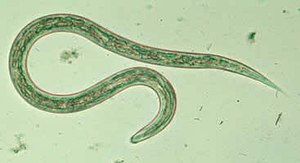Ancylostoma duodenale
| Ancylostoma duodenale | ||||||||||||
|---|---|---|---|---|---|---|---|---|---|---|---|---|

Free-living larva of Ancylostoma duodenale |
||||||||||||
| Systematics | ||||||||||||
|
||||||||||||
| Scientific name | ||||||||||||
| Ancylostoma duodenale | ||||||||||||
| ( Dubini , 1843) |
Ancylostoma duodenale (unspecific pitworm and hookworm ) is one of the two hookworm species that are pathogenic for humans andbelongto the group of roundworms .
The 8 to 12 mm long, yellowish-white tube worm lives in the small intestine of infected people .
The species occurs in southern Europe, North Africa, India, China, Southeast Asia and in certain places on the American continent. It is often found in mines , where it finds ideal conditions in terms of humidity and temperature. In the Ruhr area, the hookworm was probably introduced from southern latitudes at the end of the 19th century. It is transmitted through skin contact with soil that contains larvae. This knowledge was gained in particular in the 1880s after an ankylostomiasis epidemic broke out among the workers of the Gotthard Tunnel in Switzerland .
In herbal medicine , an extract of the worm fern Filix mas was used for therapy.
swell
Web links
- Ancylostoma duodenale, Animal Diversity Web
- Hookworm; Ancylostoma duodenale and Necator americanus
- Ancylostoma duodenale on plpnemweb.ucdavis.edu
Individual evidence
- ↑ a b BAuA : Leaflet for BK No. 3103: worm disease of miners, caused by Ankylostoma duodenale or Strongyloides stercoralis
- ↑ Hans Adolf Kühn: Round worms (Nemathelminthes). In: Ludwig Heilmeyer (ed.): Textbook of internal medicine. Springer-Verlag, Berlin / Göttingen / Heidelberg 1955; 2nd edition ibid. 1961, pp. 837-840, here: p. 840: Ankylostoma duodenale (hookworm, pit worm).
- ↑ Hans Adolf Kühn: Ankylostoma duodenale (hookworm, pit worm). In: Ludwig Heilmeyer (ed.): Textbook of internal medicine. Springer-Verlag, Berlin / Göttingen / Heidelberg 1955; 2nd edition, ibid. 1961, SS 840.
- ^ E. Bugnion: On the Epidemic Caused by Ankylostomum among the Workmen in the St. Gothard Tunnel. In: British medical journal. Volume 1, number 1054, 1881, p. 382, PMID 20749811 , PMC 2263460 (free full text).
- ^ R. Peduzzi, JC Piffaretti: Ancylostoma duodenale and the Saint Gothard anemia. In: British medical journal. Volume 287, number 6409, 1983, pp. 1942-1945, PMID 6418279 , PMC 1550193 (free full text).
- ↑ infektionsbiologie.ch: Gotthard tunnel and Ancylostoma .
- ↑ Hans Adolf Kühn: Ankylostoma duodenale (hookworm, pit worm). 1961, p. 840.

